A Research Proposal on Impacts of Technological Innovations in Banking
VerifiedAdded on 2021/05/30
|23
|5966
|90
Report
AI Summary
This research proposal examines the impact of technological innovations in the banking sector, with a specific focus on the Commonwealth Bank. The study investigates the effects of these innovations on accounting practices, service provision, and customer relationships. The research employs questionnaires and analysis of company statements to gather data on the benefits and challenges of technology adoption in banking. The findings highlight the versatility, increased quality of information, and need for staff skill development. The research also explores the application of the Diffusion of Innovation theory to understand technology adoption in the banking sector, categorizing banking innovations into customer independent, user-assisted, and customer transparent technologies. The proposal further discusses the impact of specific technologies, such as ATMs and telephone banking, on cost efficiency, customer convenience, and overall productivity within the banking industry. The study aims to provide valuable insights for accounting professionals, students, and the banking sector, assessing the effects of technological changes in business, particularly in the financial sector.
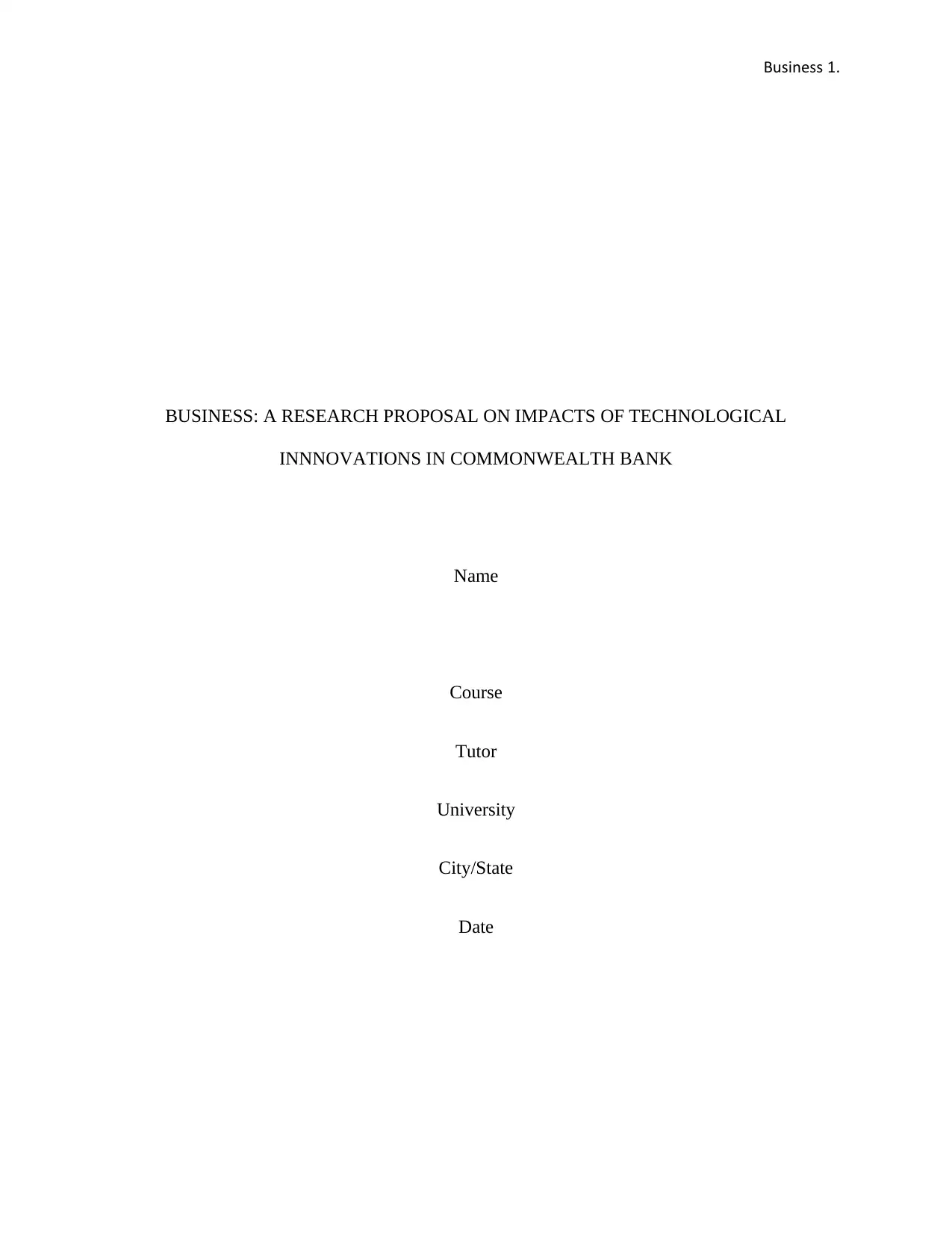
Business 1.
BUSINESS: A RESEARCH PROPOSAL ON IMPACTS OF TECHNOLOGICAL
INNNOVATIONS IN COMMONWEALTH BANK
Name
Course
Tutor
University
City/State
Date
BUSINESS: A RESEARCH PROPOSAL ON IMPACTS OF TECHNOLOGICAL
INNNOVATIONS IN COMMONWEALTH BANK
Name
Course
Tutor
University
City/State
Date
Paraphrase This Document
Need a fresh take? Get an instant paraphrase of this document with our AI Paraphraser
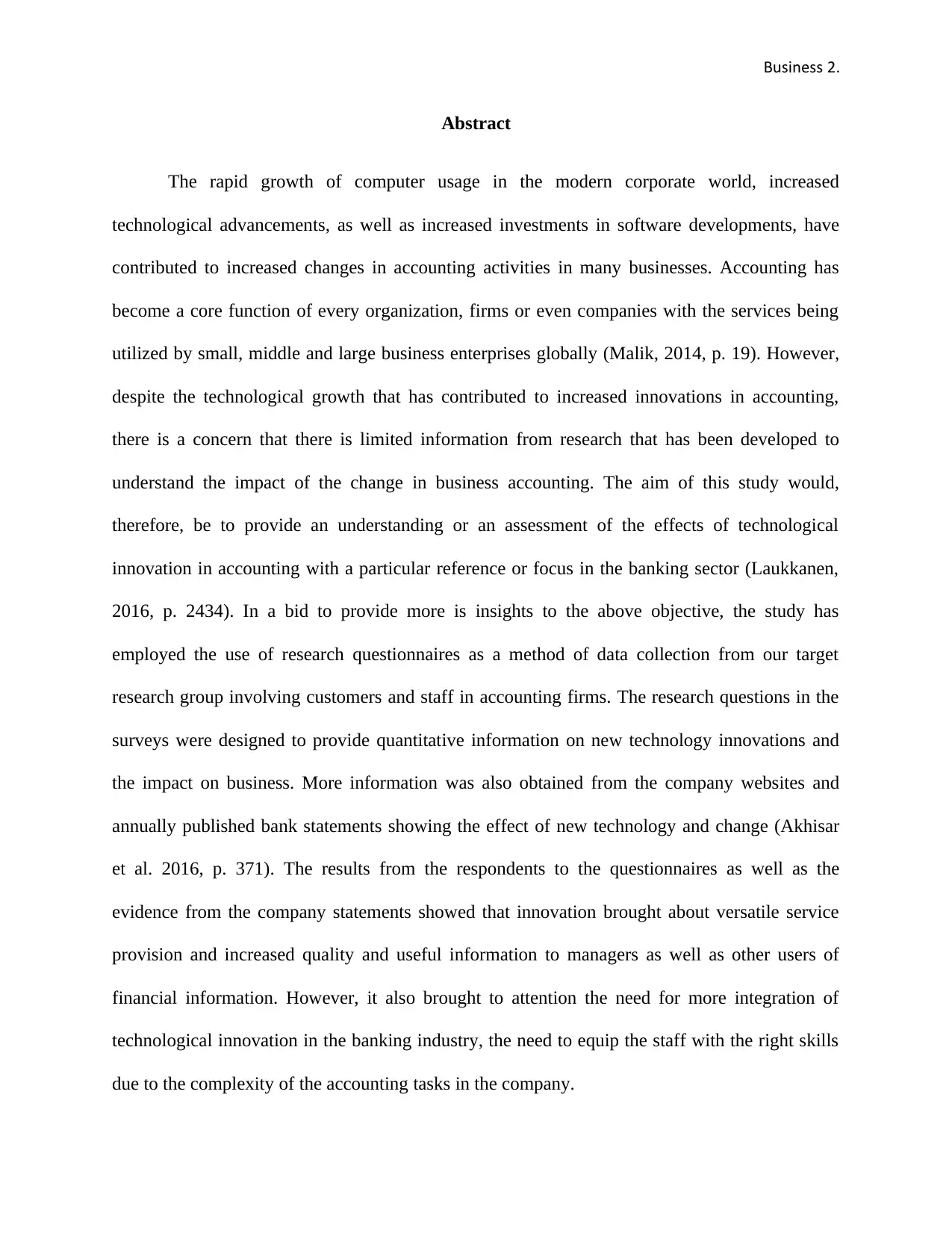
Business 2.
Abstract
The rapid growth of computer usage in the modern corporate world, increased
technological advancements, as well as increased investments in software developments, have
contributed to increased changes in accounting activities in many businesses. Accounting has
become a core function of every organization, firms or even companies with the services being
utilized by small, middle and large business enterprises globally (Malik, 2014, p. 19). However,
despite the technological growth that has contributed to increased innovations in accounting,
there is a concern that there is limited information from research that has been developed to
understand the impact of the change in business accounting. The aim of this study would,
therefore, be to provide an understanding or an assessment of the effects of technological
innovation in accounting with a particular reference or focus in the banking sector (Laukkanen,
2016, p. 2434). In a bid to provide more is insights to the above objective, the study has
employed the use of research questionnaires as a method of data collection from our target
research group involving customers and staff in accounting firms. The research questions in the
surveys were designed to provide quantitative information on new technology innovations and
the impact on business. More information was also obtained from the company websites and
annually published bank statements showing the effect of new technology and change (Akhisar
et al. 2016, p. 371). The results from the respondents to the questionnaires as well as the
evidence from the company statements showed that innovation brought about versatile service
provision and increased quality and useful information to managers as well as other users of
financial information. However, it also brought to attention the need for more integration of
technological innovation in the banking industry, the need to equip the staff with the right skills
due to the complexity of the accounting tasks in the company.
Abstract
The rapid growth of computer usage in the modern corporate world, increased
technological advancements, as well as increased investments in software developments, have
contributed to increased changes in accounting activities in many businesses. Accounting has
become a core function of every organization, firms or even companies with the services being
utilized by small, middle and large business enterprises globally (Malik, 2014, p. 19). However,
despite the technological growth that has contributed to increased innovations in accounting,
there is a concern that there is limited information from research that has been developed to
understand the impact of the change in business accounting. The aim of this study would,
therefore, be to provide an understanding or an assessment of the effects of technological
innovation in accounting with a particular reference or focus in the banking sector (Laukkanen,
2016, p. 2434). In a bid to provide more is insights to the above objective, the study has
employed the use of research questionnaires as a method of data collection from our target
research group involving customers and staff in accounting firms. The research questions in the
surveys were designed to provide quantitative information on new technology innovations and
the impact on business. More information was also obtained from the company websites and
annually published bank statements showing the effect of new technology and change (Akhisar
et al. 2016, p. 371). The results from the respondents to the questionnaires as well as the
evidence from the company statements showed that innovation brought about versatile service
provision and increased quality and useful information to managers as well as other users of
financial information. However, it also brought to attention the need for more integration of
technological innovation in the banking industry, the need to equip the staff with the right skills
due to the complexity of the accounting tasks in the company.
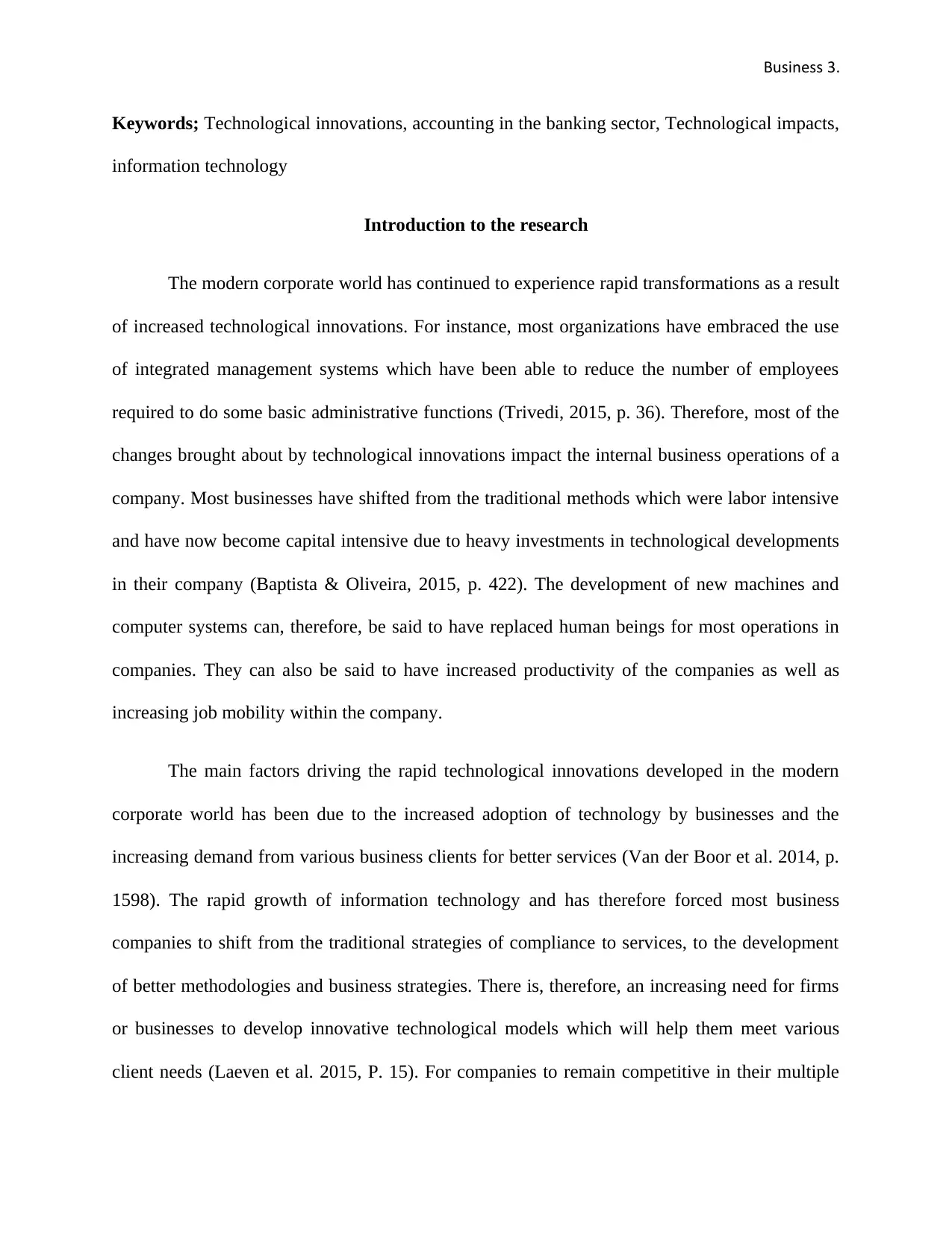
Business 3.
Keywords; Technological innovations, accounting in the banking sector, Technological impacts,
information technology
Introduction to the research
The modern corporate world has continued to experience rapid transformations as a result
of increased technological innovations. For instance, most organizations have embraced the use
of integrated management systems which have been able to reduce the number of employees
required to do some basic administrative functions (Trivedi, 2015, p. 36). Therefore, most of the
changes brought about by technological innovations impact the internal business operations of a
company. Most businesses have shifted from the traditional methods which were labor intensive
and have now become capital intensive due to heavy investments in technological developments
in their company (Baptista & Oliveira, 2015, p. 422). The development of new machines and
computer systems can, therefore, be said to have replaced human beings for most operations in
companies. They can also be said to have increased productivity of the companies as well as
increasing job mobility within the company.
The main factors driving the rapid technological innovations developed in the modern
corporate world has been due to the increased adoption of technology by businesses and the
increasing demand from various business clients for better services (Van der Boor et al. 2014, p.
1598). The rapid growth of information technology and has therefore forced most business
companies to shift from the traditional strategies of compliance to services, to the development
of better methodologies and business strategies. There is, therefore, an increasing need for firms
or businesses to develop innovative technological models which will help them meet various
client needs (Laeven et al. 2015, P. 15). For companies to remain competitive in their multiple
Keywords; Technological innovations, accounting in the banking sector, Technological impacts,
information technology
Introduction to the research
The modern corporate world has continued to experience rapid transformations as a result
of increased technological innovations. For instance, most organizations have embraced the use
of integrated management systems which have been able to reduce the number of employees
required to do some basic administrative functions (Trivedi, 2015, p. 36). Therefore, most of the
changes brought about by technological innovations impact the internal business operations of a
company. Most businesses have shifted from the traditional methods which were labor intensive
and have now become capital intensive due to heavy investments in technological developments
in their company (Baptista & Oliveira, 2015, p. 422). The development of new machines and
computer systems can, therefore, be said to have replaced human beings for most operations in
companies. They can also be said to have increased productivity of the companies as well as
increasing job mobility within the company.
The main factors driving the rapid technological innovations developed in the modern
corporate world has been due to the increased adoption of technology by businesses and the
increasing demand from various business clients for better services (Van der Boor et al. 2014, p.
1598). The rapid growth of information technology and has therefore forced most business
companies to shift from the traditional strategies of compliance to services, to the development
of better methodologies and business strategies. There is, therefore, an increasing need for firms
or businesses to develop innovative technological models which will help them meet various
client needs (Laeven et al. 2015, P. 15). For companies to remain competitive in their multiple
⊘ This is a preview!⊘
Do you want full access?
Subscribe today to unlock all pages.

Trusted by 1+ million students worldwide
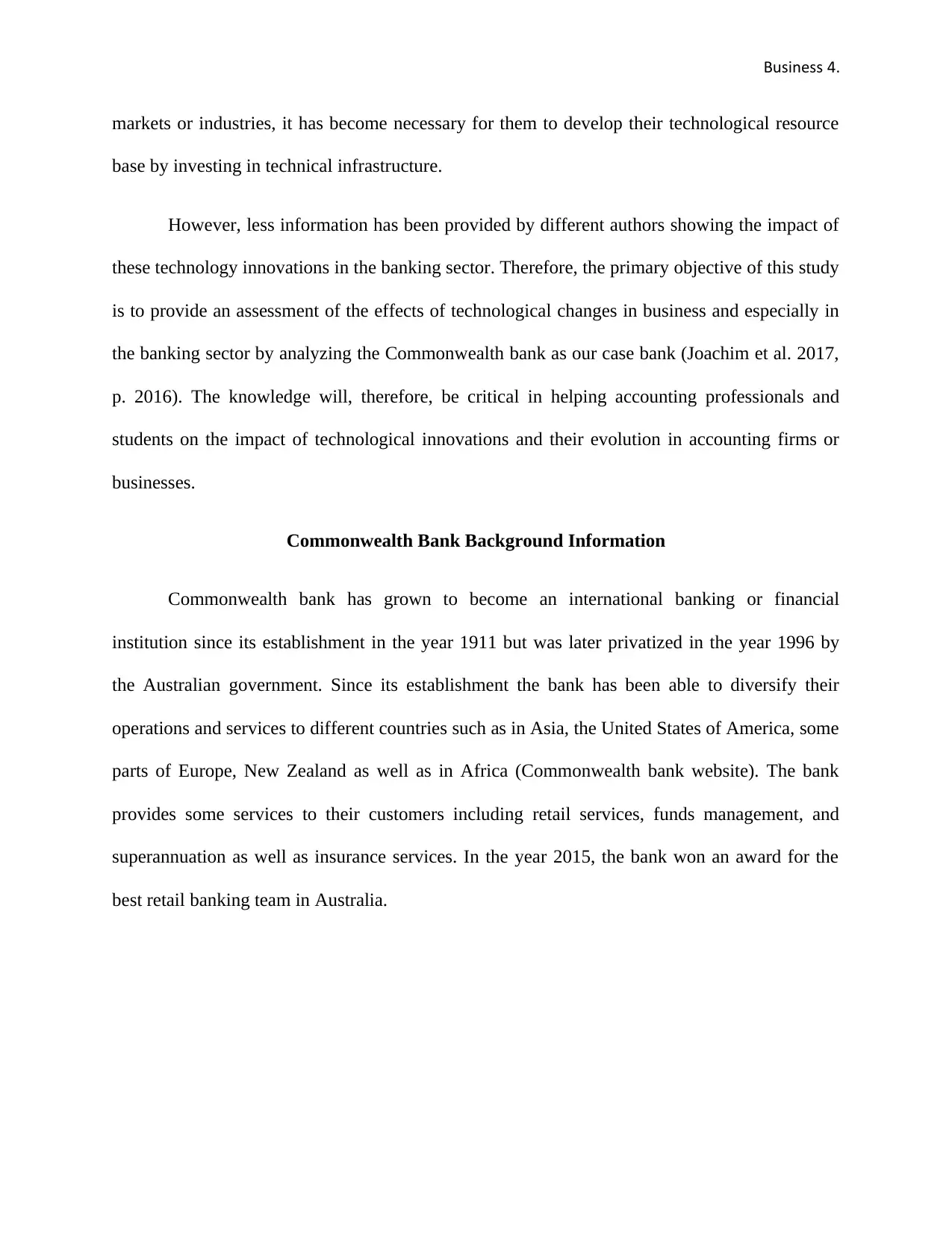
Business 4.
markets or industries, it has become necessary for them to develop their technological resource
base by investing in technical infrastructure.
However, less information has been provided by different authors showing the impact of
these technology innovations in the banking sector. Therefore, the primary objective of this study
is to provide an assessment of the effects of technological changes in business and especially in
the banking sector by analyzing the Commonwealth bank as our case bank (Joachim et al. 2017,
p. 2016). The knowledge will, therefore, be critical in helping accounting professionals and
students on the impact of technological innovations and their evolution in accounting firms or
businesses.
Commonwealth Bank Background Information
Commonwealth bank has grown to become an international banking or financial
institution since its establishment in the year 1911 but was later privatized in the year 1996 by
the Australian government. Since its establishment the bank has been able to diversify their
operations and services to different countries such as in Asia, the United States of America, some
parts of Europe, New Zealand as well as in Africa (Commonwealth bank website). The bank
provides some services to their customers including retail services, funds management, and
superannuation as well as insurance services. In the year 2015, the bank won an award for the
best retail banking team in Australia.
markets or industries, it has become necessary for them to develop their technological resource
base by investing in technical infrastructure.
However, less information has been provided by different authors showing the impact of
these technology innovations in the banking sector. Therefore, the primary objective of this study
is to provide an assessment of the effects of technological changes in business and especially in
the banking sector by analyzing the Commonwealth bank as our case bank (Joachim et al. 2017,
p. 2016). The knowledge will, therefore, be critical in helping accounting professionals and
students on the impact of technological innovations and their evolution in accounting firms or
businesses.
Commonwealth Bank Background Information
Commonwealth bank has grown to become an international banking or financial
institution since its establishment in the year 1911 but was later privatized in the year 1996 by
the Australian government. Since its establishment the bank has been able to diversify their
operations and services to different countries such as in Asia, the United States of America, some
parts of Europe, New Zealand as well as in Africa (Commonwealth bank website). The bank
provides some services to their customers including retail services, funds management, and
superannuation as well as insurance services. In the year 2015, the bank won an award for the
best retail banking team in Australia.
Paraphrase This Document
Need a fresh take? Get an instant paraphrase of this document with our AI Paraphraser
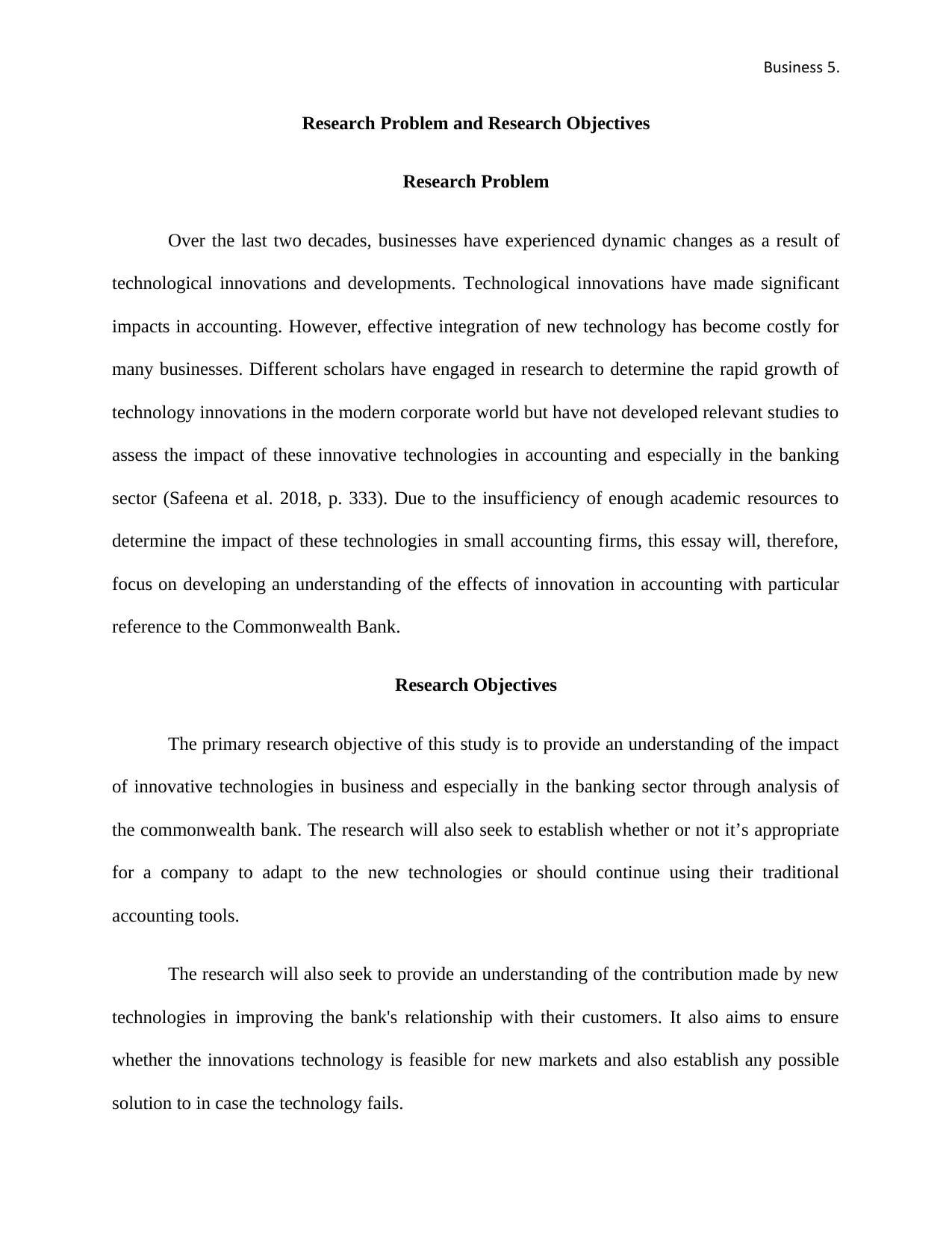
Business 5.
Research Problem and Research Objectives
Research Problem
Over the last two decades, businesses have experienced dynamic changes as a result of
technological innovations and developments. Technological innovations have made significant
impacts in accounting. However, effective integration of new technology has become costly for
many businesses. Different scholars have engaged in research to determine the rapid growth of
technology innovations in the modern corporate world but have not developed relevant studies to
assess the impact of these innovative technologies in accounting and especially in the banking
sector (Safeena et al. 2018, p. 333). Due to the insufficiency of enough academic resources to
determine the impact of these technologies in small accounting firms, this essay will, therefore,
focus on developing an understanding of the effects of innovation in accounting with particular
reference to the Commonwealth Bank.
Research Objectives
The primary research objective of this study is to provide an understanding of the impact
of innovative technologies in business and especially in the banking sector through analysis of
the commonwealth bank. The research will also seek to establish whether or not it’s appropriate
for a company to adapt to the new technologies or should continue using their traditional
accounting tools.
The research will also seek to provide an understanding of the contribution made by new
technologies in improving the bank's relationship with their customers. It also aims to ensure
whether the innovations technology is feasible for new markets and also establish any possible
solution to in case the technology fails.
Research Problem and Research Objectives
Research Problem
Over the last two decades, businesses have experienced dynamic changes as a result of
technological innovations and developments. Technological innovations have made significant
impacts in accounting. However, effective integration of new technology has become costly for
many businesses. Different scholars have engaged in research to determine the rapid growth of
technology innovations in the modern corporate world but have not developed relevant studies to
assess the impact of these innovative technologies in accounting and especially in the banking
sector (Safeena et al. 2018, p. 333). Due to the insufficiency of enough academic resources to
determine the impact of these technologies in small accounting firms, this essay will, therefore,
focus on developing an understanding of the effects of innovation in accounting with particular
reference to the Commonwealth Bank.
Research Objectives
The primary research objective of this study is to provide an understanding of the impact
of innovative technologies in business and especially in the banking sector through analysis of
the commonwealth bank. The research will also seek to establish whether or not it’s appropriate
for a company to adapt to the new technologies or should continue using their traditional
accounting tools.
The research will also seek to provide an understanding of the contribution made by new
technologies in improving the bank's relationship with their customers. It also aims to ensure
whether the innovations technology is feasible for new markets and also establish any possible
solution to in case the technology fails.
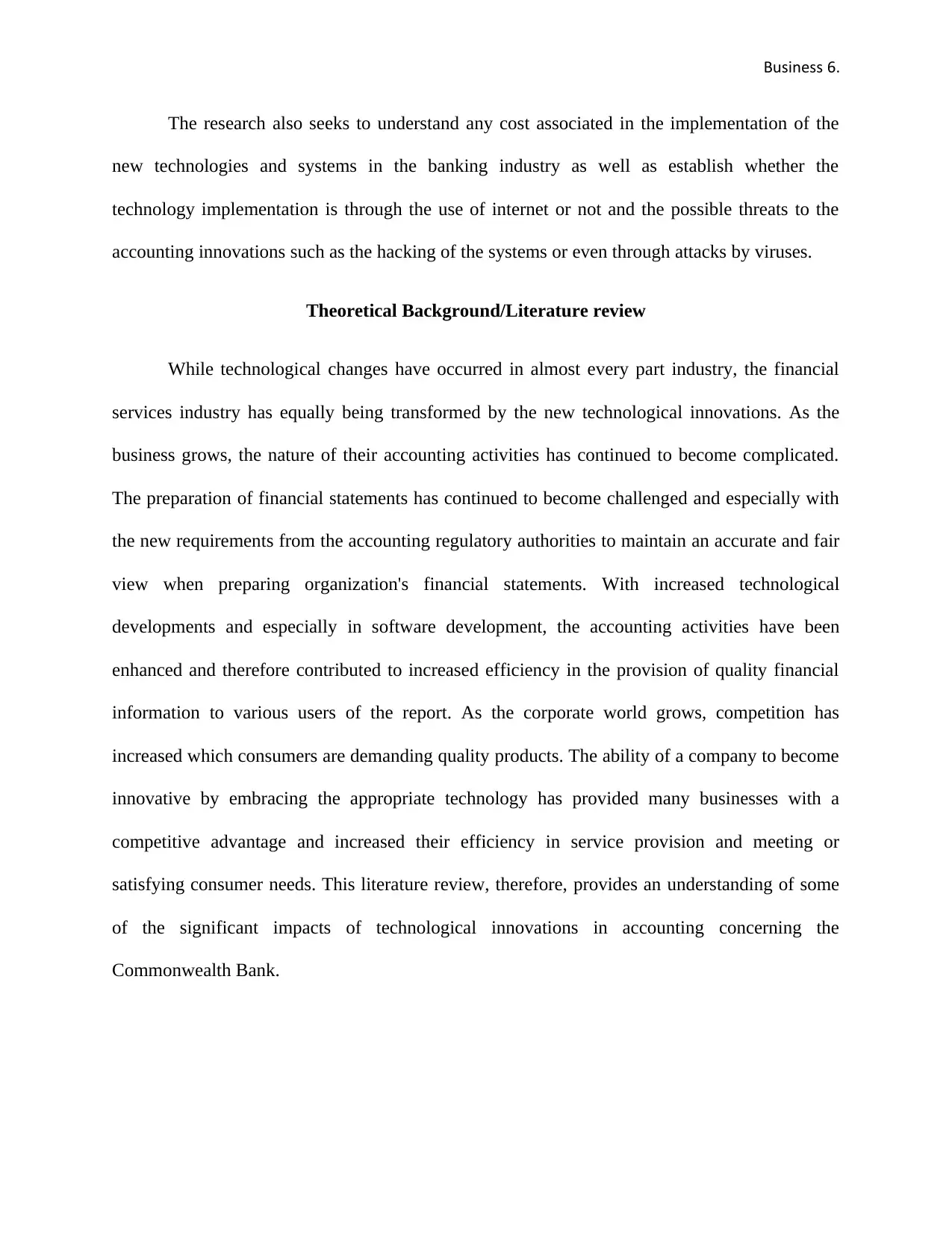
Business 6.
The research also seeks to understand any cost associated in the implementation of the
new technologies and systems in the banking industry as well as establish whether the
technology implementation is through the use of internet or not and the possible threats to the
accounting innovations such as the hacking of the systems or even through attacks by viruses.
Theoretical Background/Literature review
While technological changes have occurred in almost every part industry, the financial
services industry has equally being transformed by the new technological innovations. As the
business grows, the nature of their accounting activities has continued to become complicated.
The preparation of financial statements has continued to become challenged and especially with
the new requirements from the accounting regulatory authorities to maintain an accurate and fair
view when preparing organization's financial statements. With increased technological
developments and especially in software development, the accounting activities have been
enhanced and therefore contributed to increased efficiency in the provision of quality financial
information to various users of the report. As the corporate world grows, competition has
increased which consumers are demanding quality products. The ability of a company to become
innovative by embracing the appropriate technology has provided many businesses with a
competitive advantage and increased their efficiency in service provision and meeting or
satisfying consumer needs. This literature review, therefore, provides an understanding of some
of the significant impacts of technological innovations in accounting concerning the
Commonwealth Bank.
The research also seeks to understand any cost associated in the implementation of the
new technologies and systems in the banking industry as well as establish whether the
technology implementation is through the use of internet or not and the possible threats to the
accounting innovations such as the hacking of the systems or even through attacks by viruses.
Theoretical Background/Literature review
While technological changes have occurred in almost every part industry, the financial
services industry has equally being transformed by the new technological innovations. As the
business grows, the nature of their accounting activities has continued to become complicated.
The preparation of financial statements has continued to become challenged and especially with
the new requirements from the accounting regulatory authorities to maintain an accurate and fair
view when preparing organization's financial statements. With increased technological
developments and especially in software development, the accounting activities have been
enhanced and therefore contributed to increased efficiency in the provision of quality financial
information to various users of the report. As the corporate world grows, competition has
increased which consumers are demanding quality products. The ability of a company to become
innovative by embracing the appropriate technology has provided many businesses with a
competitive advantage and increased their efficiency in service provision and meeting or
satisfying consumer needs. This literature review, therefore, provides an understanding of some
of the significant impacts of technological innovations in accounting concerning the
Commonwealth Bank.
⊘ This is a preview!⊘
Do you want full access?
Subscribe today to unlock all pages.

Trusted by 1+ million students worldwide
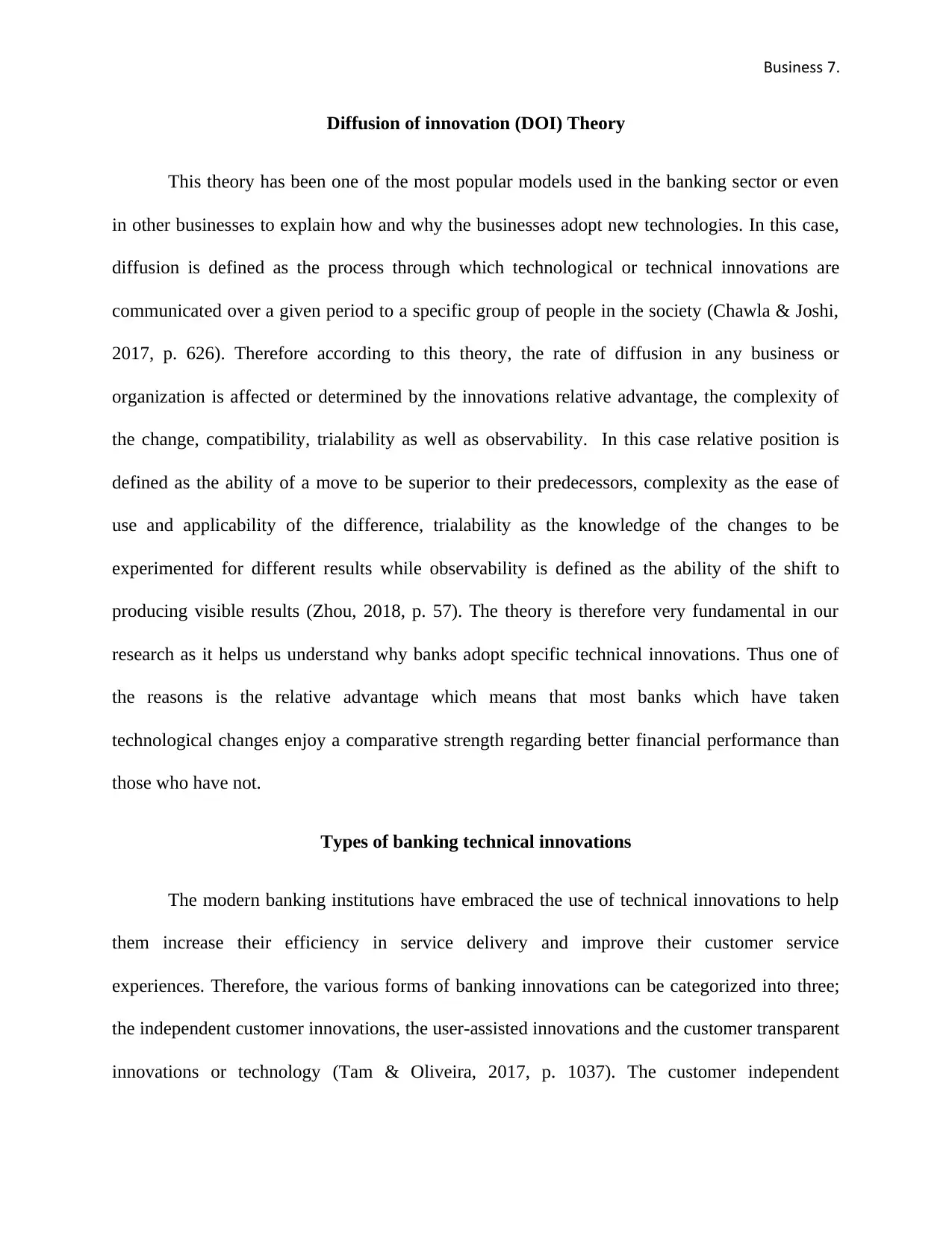
Business 7.
Diffusion of innovation (DOI) Theory
This theory has been one of the most popular models used in the banking sector or even
in other businesses to explain how and why the businesses adopt new technologies. In this case,
diffusion is defined as the process through which technological or technical innovations are
communicated over a given period to a specific group of people in the society (Chawla & Joshi,
2017, p. 626). Therefore according to this theory, the rate of diffusion in any business or
organization is affected or determined by the innovations relative advantage, the complexity of
the change, compatibility, trialability as well as observability. In this case relative position is
defined as the ability of a move to be superior to their predecessors, complexity as the ease of
use and applicability of the difference, trialability as the knowledge of the changes to be
experimented for different results while observability is defined as the ability of the shift to
producing visible results (Zhou, 2018, p. 57). The theory is therefore very fundamental in our
research as it helps us understand why banks adopt specific technical innovations. Thus one of
the reasons is the relative advantage which means that most banks which have taken
technological changes enjoy a comparative strength regarding better financial performance than
those who have not.
Types of banking technical innovations
The modern banking institutions have embraced the use of technical innovations to help
them increase their efficiency in service delivery and improve their customer service
experiences. Therefore, the various forms of banking innovations can be categorized into three;
the independent customer innovations, the user-assisted innovations and the customer transparent
innovations or technology (Tam & Oliveira, 2017, p. 1037). The customer independent
Diffusion of innovation (DOI) Theory
This theory has been one of the most popular models used in the banking sector or even
in other businesses to explain how and why the businesses adopt new technologies. In this case,
diffusion is defined as the process through which technological or technical innovations are
communicated over a given period to a specific group of people in the society (Chawla & Joshi,
2017, p. 626). Therefore according to this theory, the rate of diffusion in any business or
organization is affected or determined by the innovations relative advantage, the complexity of
the change, compatibility, trialability as well as observability. In this case relative position is
defined as the ability of a move to be superior to their predecessors, complexity as the ease of
use and applicability of the difference, trialability as the knowledge of the changes to be
experimented for different results while observability is defined as the ability of the shift to
producing visible results (Zhou, 2018, p. 57). The theory is therefore very fundamental in our
research as it helps us understand why banks adopt specific technical innovations. Thus one of
the reasons is the relative advantage which means that most banks which have taken
technological changes enjoy a comparative strength regarding better financial performance than
those who have not.
Types of banking technical innovations
The modern banking institutions have embraced the use of technical innovations to help
them increase their efficiency in service delivery and improve their customer service
experiences. Therefore, the various forms of banking innovations can be categorized into three;
the independent customer innovations, the user-assisted innovations and the customer transparent
innovations or technology (Tam & Oliveira, 2017, p. 1037). The customer independent
Paraphrase This Document
Need a fresh take? Get an instant paraphrase of this document with our AI Paraphraser
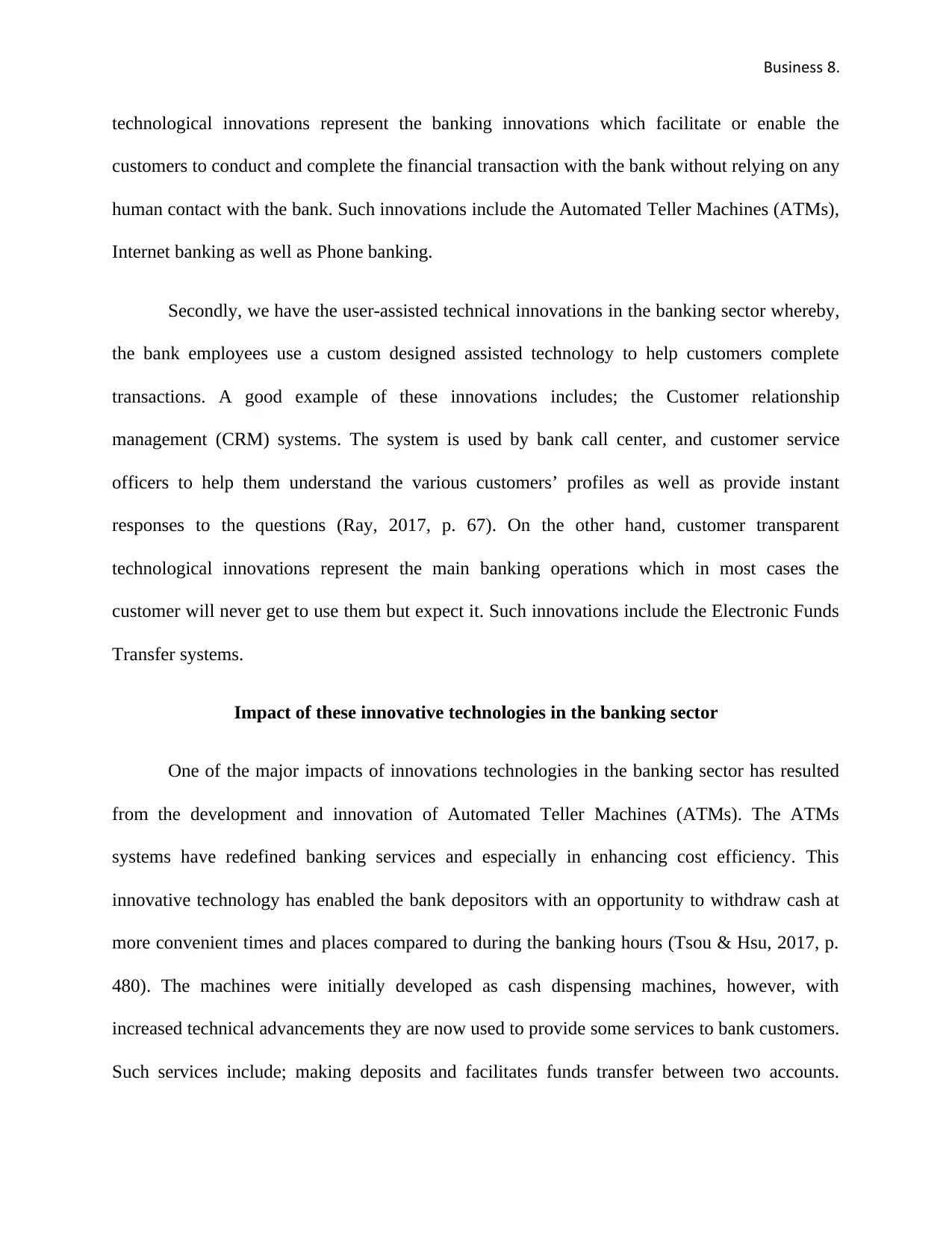
Business 8.
technological innovations represent the banking innovations which facilitate or enable the
customers to conduct and complete the financial transaction with the bank without relying on any
human contact with the bank. Such innovations include the Automated Teller Machines (ATMs),
Internet banking as well as Phone banking.
Secondly, we have the user-assisted technical innovations in the banking sector whereby,
the bank employees use a custom designed assisted technology to help customers complete
transactions. A good example of these innovations includes; the Customer relationship
management (CRM) systems. The system is used by bank call center, and customer service
officers to help them understand the various customers’ profiles as well as provide instant
responses to the questions (Ray, 2017, p. 67). On the other hand, customer transparent
technological innovations represent the main banking operations which in most cases the
customer will never get to use them but expect it. Such innovations include the Electronic Funds
Transfer systems.
Impact of these innovative technologies in the banking sector
One of the major impacts of innovations technologies in the banking sector has resulted
from the development and innovation of Automated Teller Machines (ATMs). The ATMs
systems have redefined banking services and especially in enhancing cost efficiency. This
innovative technology has enabled the bank depositors with an opportunity to withdraw cash at
more convenient times and places compared to during the banking hours (Tsou & Hsu, 2017, p.
480). The machines were initially developed as cash dispensing machines, however, with
increased technical advancements they are now used to provide some services to bank customers.
Such services include; making deposits and facilitates funds transfer between two accounts.
technological innovations represent the banking innovations which facilitate or enable the
customers to conduct and complete the financial transaction with the bank without relying on any
human contact with the bank. Such innovations include the Automated Teller Machines (ATMs),
Internet banking as well as Phone banking.
Secondly, we have the user-assisted technical innovations in the banking sector whereby,
the bank employees use a custom designed assisted technology to help customers complete
transactions. A good example of these innovations includes; the Customer relationship
management (CRM) systems. The system is used by bank call center, and customer service
officers to help them understand the various customers’ profiles as well as provide instant
responses to the questions (Ray, 2017, p. 67). On the other hand, customer transparent
technological innovations represent the main banking operations which in most cases the
customer will never get to use them but expect it. Such innovations include the Electronic Funds
Transfer systems.
Impact of these innovative technologies in the banking sector
One of the major impacts of innovations technologies in the banking sector has resulted
from the development and innovation of Automated Teller Machines (ATMs). The ATMs
systems have redefined banking services and especially in enhancing cost efficiency. This
innovative technology has enabled the bank depositors with an opportunity to withdraw cash at
more convenient times and places compared to during the banking hours (Tsou & Hsu, 2017, p.
480). The machines were initially developed as cash dispensing machines, however, with
increased technical advancements they are now used to provide some services to bank customers.
Such services include; making deposits and facilitates funds transfer between two accounts.
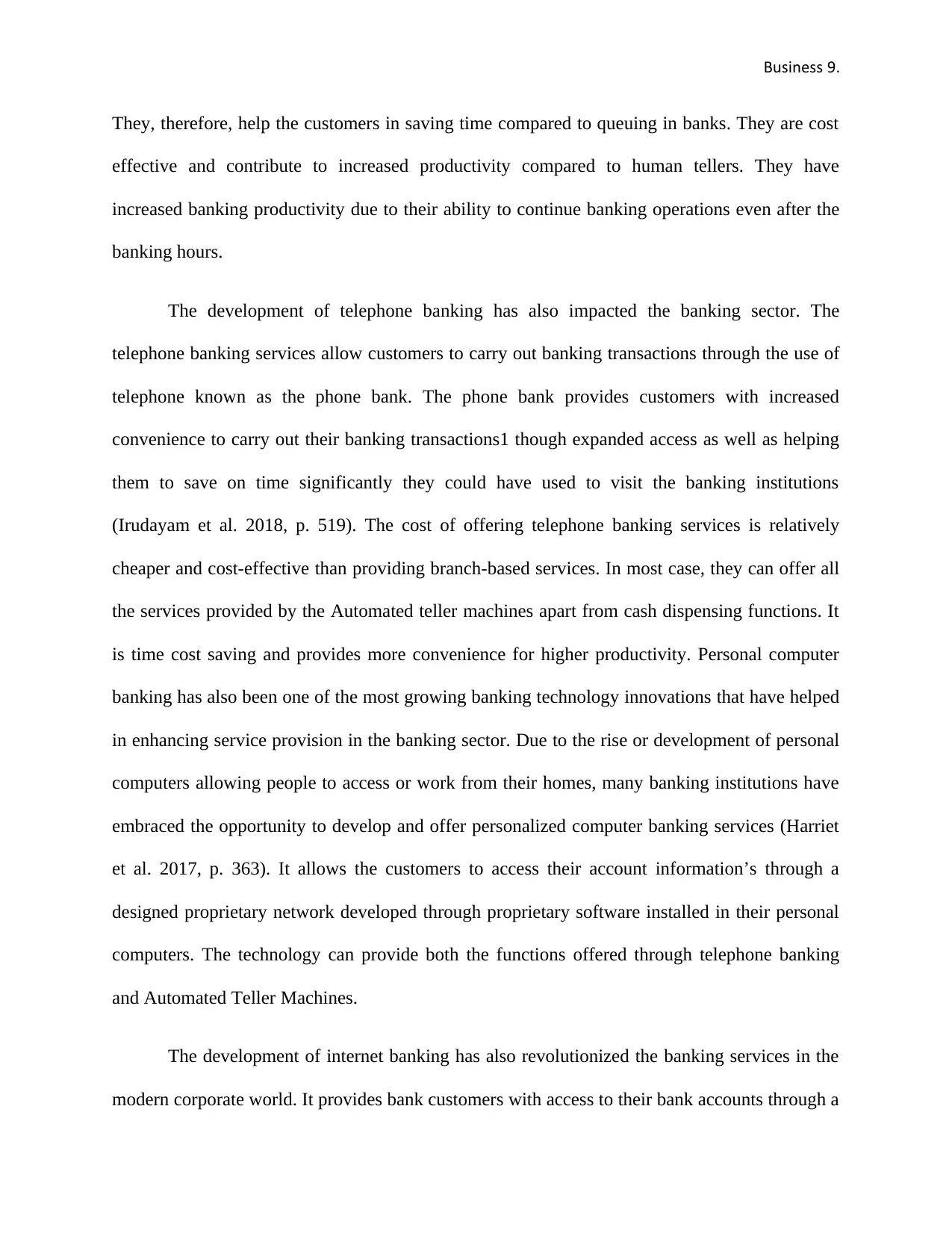
Business 9.
They, therefore, help the customers in saving time compared to queuing in banks. They are cost
effective and contribute to increased productivity compared to human tellers. They have
increased banking productivity due to their ability to continue banking operations even after the
banking hours.
The development of telephone banking has also impacted the banking sector. The
telephone banking services allow customers to carry out banking transactions through the use of
telephone known as the phone bank. The phone bank provides customers with increased
convenience to carry out their banking transactions1 though expanded access as well as helping
them to save on time significantly they could have used to visit the banking institutions
(Irudayam et al. 2018, p. 519). The cost of offering telephone banking services is relatively
cheaper and cost-effective than providing branch-based services. In most case, they can offer all
the services provided by the Automated teller machines apart from cash dispensing functions. It
is time cost saving and provides more convenience for higher productivity. Personal computer
banking has also been one of the most growing banking technology innovations that have helped
in enhancing service provision in the banking sector. Due to the rise or development of personal
computers allowing people to access or work from their homes, many banking institutions have
embraced the opportunity to develop and offer personalized computer banking services (Harriet
et al. 2017, p. 363). It allows the customers to access their account information’s through a
designed proprietary network developed through proprietary software installed in their personal
computers. The technology can provide both the functions offered through telephone banking
and Automated Teller Machines.
The development of internet banking has also revolutionized the banking services in the
modern corporate world. It provides bank customers with access to their bank accounts through a
They, therefore, help the customers in saving time compared to queuing in banks. They are cost
effective and contribute to increased productivity compared to human tellers. They have
increased banking productivity due to their ability to continue banking operations even after the
banking hours.
The development of telephone banking has also impacted the banking sector. The
telephone banking services allow customers to carry out banking transactions through the use of
telephone known as the phone bank. The phone bank provides customers with increased
convenience to carry out their banking transactions1 though expanded access as well as helping
them to save on time significantly they could have used to visit the banking institutions
(Irudayam et al. 2018, p. 519). The cost of offering telephone banking services is relatively
cheaper and cost-effective than providing branch-based services. In most case, they can offer all
the services provided by the Automated teller machines apart from cash dispensing functions. It
is time cost saving and provides more convenience for higher productivity. Personal computer
banking has also been one of the most growing banking technology innovations that have helped
in enhancing service provision in the banking sector. Due to the rise or development of personal
computers allowing people to access or work from their homes, many banking institutions have
embraced the opportunity to develop and offer personalized computer banking services (Harriet
et al. 2017, p. 363). It allows the customers to access their account information’s through a
designed proprietary network developed through proprietary software installed in their personal
computers. The technology can provide both the functions offered through telephone banking
and Automated Teller Machines.
The development of internet banking has also revolutionized the banking services in the
modern corporate world. It provides bank customers with access to their bank accounts through a
⊘ This is a preview!⊘
Do you want full access?
Subscribe today to unlock all pages.

Trusted by 1+ million students worldwide
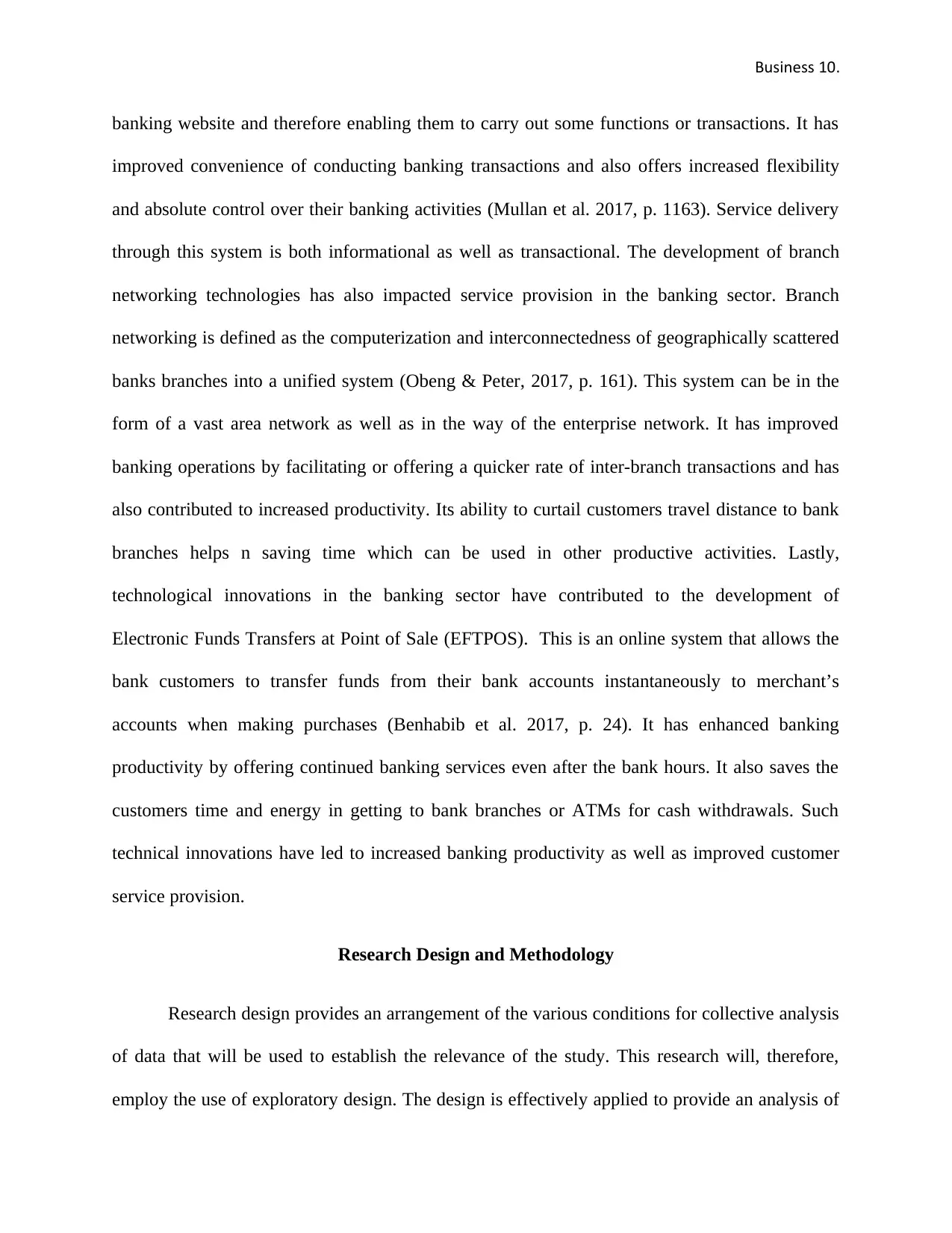
Business 10.
banking website and therefore enabling them to carry out some functions or transactions. It has
improved convenience of conducting banking transactions and also offers increased flexibility
and absolute control over their banking activities (Mullan et al. 2017, p. 1163). Service delivery
through this system is both informational as well as transactional. The development of branch
networking technologies has also impacted service provision in the banking sector. Branch
networking is defined as the computerization and interconnectedness of geographically scattered
banks branches into a unified system (Obeng & Peter, 2017, p. 161). This system can be in the
form of a vast area network as well as in the way of the enterprise network. It has improved
banking operations by facilitating or offering a quicker rate of inter-branch transactions and has
also contributed to increased productivity. Its ability to curtail customers travel distance to bank
branches helps n saving time which can be used in other productive activities. Lastly,
technological innovations in the banking sector have contributed to the development of
Electronic Funds Transfers at Point of Sale (EFTPOS). This is an online system that allows the
bank customers to transfer funds from their bank accounts instantaneously to merchant’s
accounts when making purchases (Benhabib et al. 2017, p. 24). It has enhanced banking
productivity by offering continued banking services even after the bank hours. It also saves the
customers time and energy in getting to bank branches or ATMs for cash withdrawals. Such
technical innovations have led to increased banking productivity as well as improved customer
service provision.
Research Design and Methodology
Research design provides an arrangement of the various conditions for collective analysis
of data that will be used to establish the relevance of the study. This research will, therefore,
employ the use of exploratory design. The design is effectively applied to provide an analysis of
banking website and therefore enabling them to carry out some functions or transactions. It has
improved convenience of conducting banking transactions and also offers increased flexibility
and absolute control over their banking activities (Mullan et al. 2017, p. 1163). Service delivery
through this system is both informational as well as transactional. The development of branch
networking technologies has also impacted service provision in the banking sector. Branch
networking is defined as the computerization and interconnectedness of geographically scattered
banks branches into a unified system (Obeng & Peter, 2017, p. 161). This system can be in the
form of a vast area network as well as in the way of the enterprise network. It has improved
banking operations by facilitating or offering a quicker rate of inter-branch transactions and has
also contributed to increased productivity. Its ability to curtail customers travel distance to bank
branches helps n saving time which can be used in other productive activities. Lastly,
technological innovations in the banking sector have contributed to the development of
Electronic Funds Transfers at Point of Sale (EFTPOS). This is an online system that allows the
bank customers to transfer funds from their bank accounts instantaneously to merchant’s
accounts when making purchases (Benhabib et al. 2017, p. 24). It has enhanced banking
productivity by offering continued banking services even after the bank hours. It also saves the
customers time and energy in getting to bank branches or ATMs for cash withdrawals. Such
technical innovations have led to increased banking productivity as well as improved customer
service provision.
Research Design and Methodology
Research design provides an arrangement of the various conditions for collective analysis
of data that will be used to establish the relevance of the study. This research will, therefore,
employ the use of exploratory design. The design is effectively applied to provide an analysis of
Paraphrase This Document
Need a fresh take? Get an instant paraphrase of this document with our AI Paraphraser
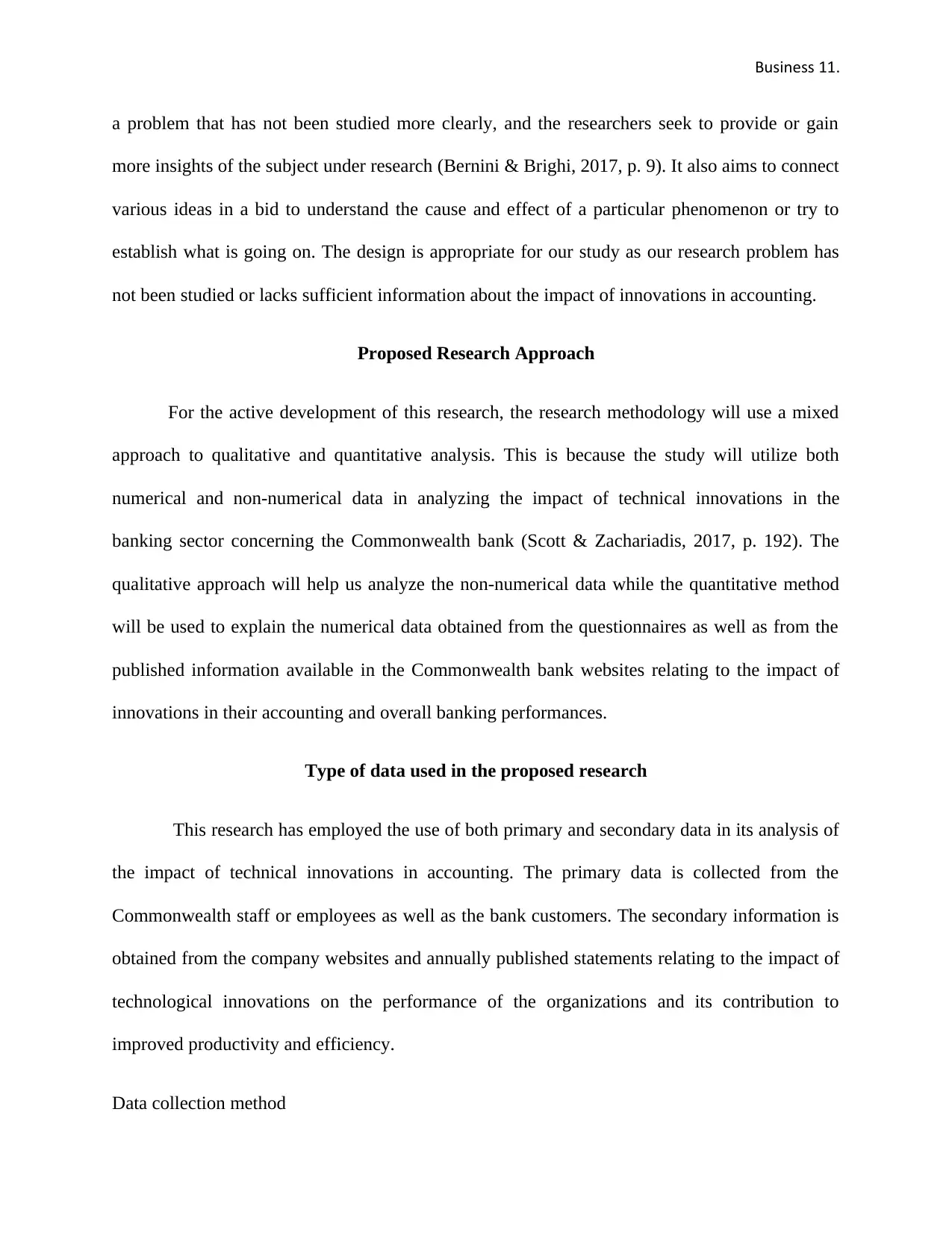
Business 11.
a problem that has not been studied more clearly, and the researchers seek to provide or gain
more insights of the subject under research (Bernini & Brighi, 2017, p. 9). It also aims to connect
various ideas in a bid to understand the cause and effect of a particular phenomenon or try to
establish what is going on. The design is appropriate for our study as our research problem has
not been studied or lacks sufficient information about the impact of innovations in accounting.
Proposed Research Approach
For the active development of this research, the research methodology will use a mixed
approach to qualitative and quantitative analysis. This is because the study will utilize both
numerical and non-numerical data in analyzing the impact of technical innovations in the
banking sector concerning the Commonwealth bank (Scott & Zachariadis, 2017, p. 192). The
qualitative approach will help us analyze the non-numerical data while the quantitative method
will be used to explain the numerical data obtained from the questionnaires as well as from the
published information available in the Commonwealth bank websites relating to the impact of
innovations in their accounting and overall banking performances.
Type of data used in the proposed research
This research has employed the use of both primary and secondary data in its analysis of
the impact of technical innovations in accounting. The primary data is collected from the
Commonwealth staff or employees as well as the bank customers. The secondary information is
obtained from the company websites and annually published statements relating to the impact of
technological innovations on the performance of the organizations and its contribution to
improved productivity and efficiency.
Data collection method
a problem that has not been studied more clearly, and the researchers seek to provide or gain
more insights of the subject under research (Bernini & Brighi, 2017, p. 9). It also aims to connect
various ideas in a bid to understand the cause and effect of a particular phenomenon or try to
establish what is going on. The design is appropriate for our study as our research problem has
not been studied or lacks sufficient information about the impact of innovations in accounting.
Proposed Research Approach
For the active development of this research, the research methodology will use a mixed
approach to qualitative and quantitative analysis. This is because the study will utilize both
numerical and non-numerical data in analyzing the impact of technical innovations in the
banking sector concerning the Commonwealth bank (Scott & Zachariadis, 2017, p. 192). The
qualitative approach will help us analyze the non-numerical data while the quantitative method
will be used to explain the numerical data obtained from the questionnaires as well as from the
published information available in the Commonwealth bank websites relating to the impact of
innovations in their accounting and overall banking performances.
Type of data used in the proposed research
This research has employed the use of both primary and secondary data in its analysis of
the impact of technical innovations in accounting. The primary data is collected from the
Commonwealth staff or employees as well as the bank customers. The secondary information is
obtained from the company websites and annually published statements relating to the impact of
technological innovations on the performance of the organizations and its contribution to
improved productivity and efficiency.
Data collection method
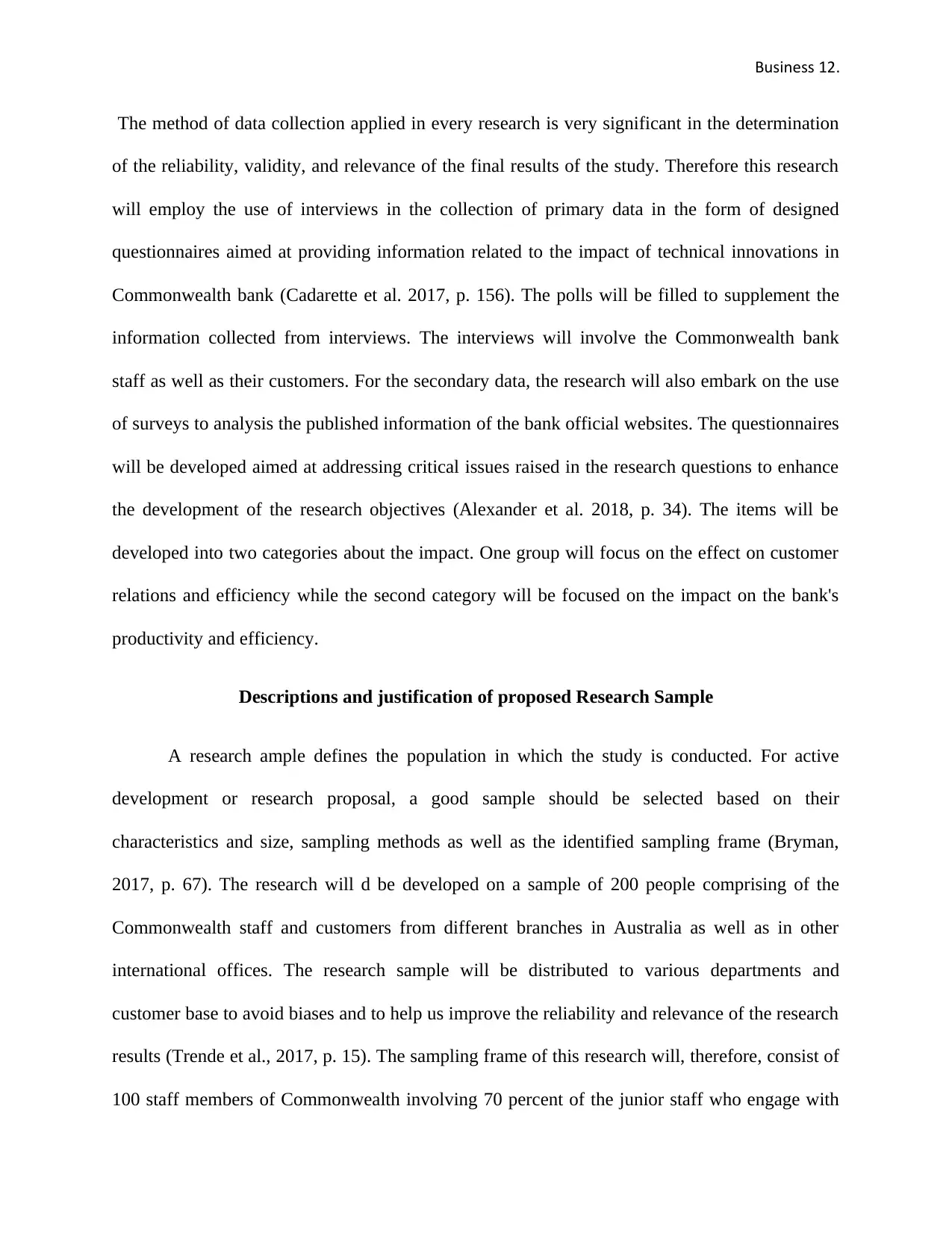
Business 12.
The method of data collection applied in every research is very significant in the determination
of the reliability, validity, and relevance of the final results of the study. Therefore this research
will employ the use of interviews in the collection of primary data in the form of designed
questionnaires aimed at providing information related to the impact of technical innovations in
Commonwealth bank (Cadarette et al. 2017, p. 156). The polls will be filled to supplement the
information collected from interviews. The interviews will involve the Commonwealth bank
staff as well as their customers. For the secondary data, the research will also embark on the use
of surveys to analysis the published information of the bank official websites. The questionnaires
will be developed aimed at addressing critical issues raised in the research questions to enhance
the development of the research objectives (Alexander et al. 2018, p. 34). The items will be
developed into two categories about the impact. One group will focus on the effect on customer
relations and efficiency while the second category will be focused on the impact on the bank's
productivity and efficiency.
Descriptions and justification of proposed Research Sample
A research ample defines the population in which the study is conducted. For active
development or research proposal, a good sample should be selected based on their
characteristics and size, sampling methods as well as the identified sampling frame (Bryman,
2017, p. 67). The research will d be developed on a sample of 200 people comprising of the
Commonwealth staff and customers from different branches in Australia as well as in other
international offices. The research sample will be distributed to various departments and
customer base to avoid biases and to help us improve the reliability and relevance of the research
results (Trende et al., 2017, p. 15). The sampling frame of this research will, therefore, consist of
100 staff members of Commonwealth involving 70 percent of the junior staff who engage with
The method of data collection applied in every research is very significant in the determination
of the reliability, validity, and relevance of the final results of the study. Therefore this research
will employ the use of interviews in the collection of primary data in the form of designed
questionnaires aimed at providing information related to the impact of technical innovations in
Commonwealth bank (Cadarette et al. 2017, p. 156). The polls will be filled to supplement the
information collected from interviews. The interviews will involve the Commonwealth bank
staff as well as their customers. For the secondary data, the research will also embark on the use
of surveys to analysis the published information of the bank official websites. The questionnaires
will be developed aimed at addressing critical issues raised in the research questions to enhance
the development of the research objectives (Alexander et al. 2018, p. 34). The items will be
developed into two categories about the impact. One group will focus on the effect on customer
relations and efficiency while the second category will be focused on the impact on the bank's
productivity and efficiency.
Descriptions and justification of proposed Research Sample
A research ample defines the population in which the study is conducted. For active
development or research proposal, a good sample should be selected based on their
characteristics and size, sampling methods as well as the identified sampling frame (Bryman,
2017, p. 67). The research will d be developed on a sample of 200 people comprising of the
Commonwealth staff and customers from different branches in Australia as well as in other
international offices. The research sample will be distributed to various departments and
customer base to avoid biases and to help us improve the reliability and relevance of the research
results (Trende et al., 2017, p. 15). The sampling frame of this research will, therefore, consist of
100 staff members of Commonwealth involving 70 percent of the junior staff who engage with
⊘ This is a preview!⊘
Do you want full access?
Subscribe today to unlock all pages.

Trusted by 1+ million students worldwide
1 out of 23
Related Documents
Your All-in-One AI-Powered Toolkit for Academic Success.
+13062052269
info@desklib.com
Available 24*7 on WhatsApp / Email
![[object Object]](/_next/static/media/star-bottom.7253800d.svg)
Unlock your academic potential
Copyright © 2020–2025 A2Z Services. All Rights Reserved. Developed and managed by ZUCOL.





